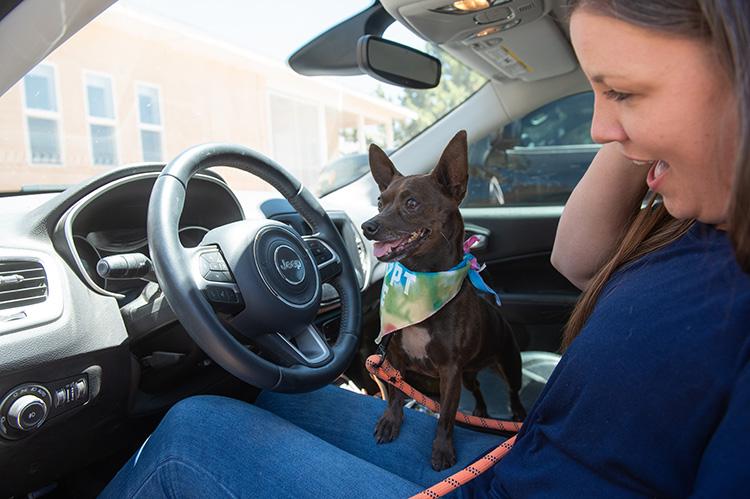How to Help Dogs Adapt to a Busier Lifestyle

Have you just adopted a dog who isn't used to a lot of social interaction and adventure? Or maybe your once-quiet lifestyle with your pup has recently gotten a lot busier. Here are some tips from Best Friends Animal Society's Dr. Carley Faughn to help dogs adjust to a busier lifestyle.
Helping dogs socialize
Some dogs might be perfectly comfortable with the people (and pets) they live with but wary of other social interaction. If that's the case, here are some tips to help them gain more positive social experiences:
- Take your dog for walks with friends. People your pup has met before are ideal, but anyone will do. Gather some treats for your dog, and have a friend meet you outside with your dog already on leash. Before you begin walking, let your friend offer a treat by tossing it to your dog. Don’t have your friend do the hand-extended-for-a-sniff introduction if this makes your dog nervous. Just walk together, and keep the treats coming. Every time your dog looks at your friend, give the dog another treat so they'll associate the friend with treats.
- Invite people to your house and have them toss a treat to your dog when they come in. They can continue to give your dog treats every time the dog looks at them. (If you have more than one dog, give separate treats so there’s no arguing.) And if toys are more your dog’s thing, you can use those, too. A quick game of tug can just as easily be a reward as a treat.
- Try our dog training plan called "look at that." This can help with dogs who are taking a long time adjusting to meeting new people.
These tips are for relatively minor to moderate shyness, discomfort, or poor manners. If the problem is more serious, such as the dog lunging at people, you’ll want the help of a pet behavior consultant in your area. You can find some via the International Association of Animal Behavior Consultants.
Basket muzzle training can also be a big help if you’re concerned about everyone’s safety. And yes, a dog can still receive treats through a muzzle.
Traveling with dogs
If your dog is bewildered by the wonders and woes of traveling, here are some tips for getting ready for a getaway:
- Try a few short car rides before doing a long one. It might seem obvious, but the movement of a car can be something that takes getting used to for dogs who don't have a lot of experience with it. So before you buckle up for a cross-country adventure, be sure your dog is comfortable with a drive around the block. From there, gradually increase the duration of the rides.
- When you book a pet-friendly hotel, find out whether you’ll need an elevator or stairs to get to your room. If the only option is an elevator and you think your dog might have a problem with that, practice ahead of time by riding an elevator. The same goes for a flight of stairs if your dog doesn't have experience with stairs. When in doubt, try to get a room on the first floor.
- If you'll be leaving your dog alone in the vacation rental or hotel you’re staying in, be prepared. Bring a crate, and be sure to crate-train your dog before leaving home. And don’t forget to bring safe toys to occupy your dog while you’re gone.
Finally, no matter what your plans are, keep practicing those basic cues: sit, stay, come. That kind of two-way communication not only gives you quality time together and helps you bond, but it also gives your dog confidence. The outside world is less scary when “sit” always means “sit,” no matter where you are.
So practice those skills when you’re at home and also when you’re out and about. It can help your pup understand that even when the world seems like an intimidating place, they can always rely on a comforting routine and the love of their people.